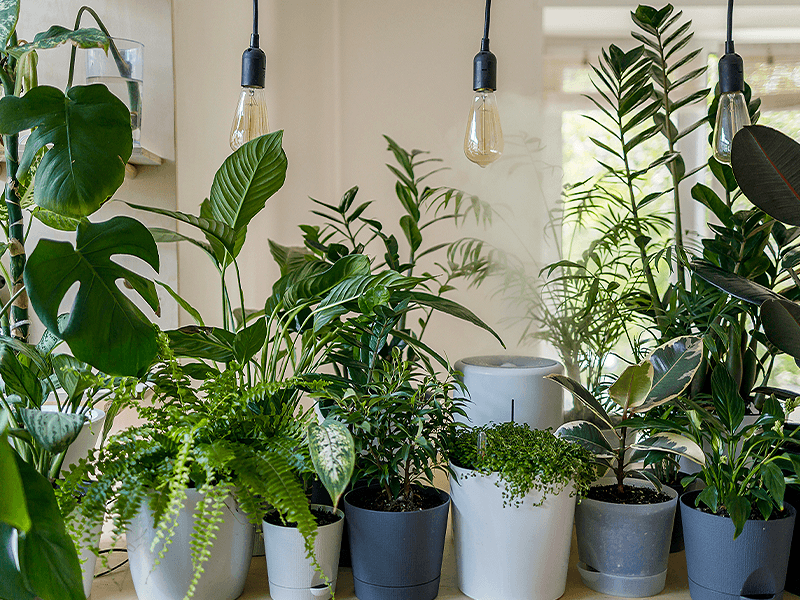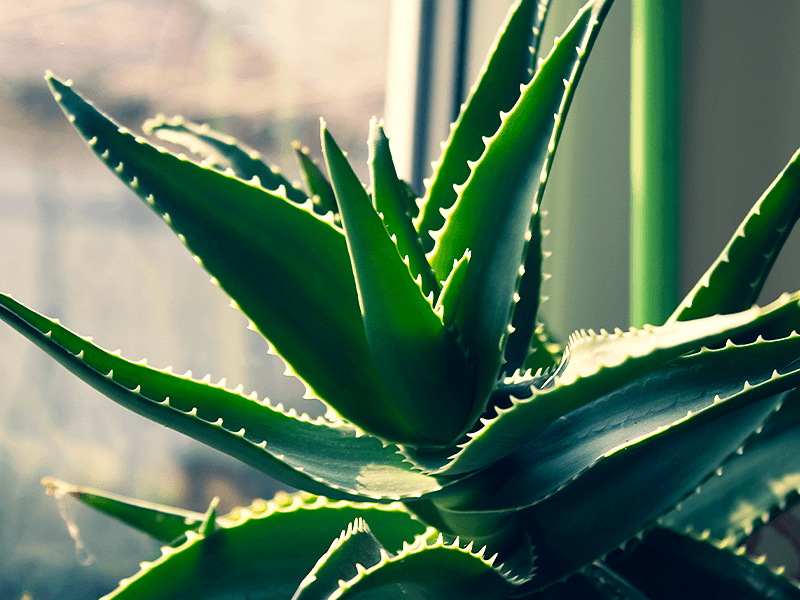If you want to improve the health and well-being of your house in a simple and natural method, you might try adding some air-purifying plants to your interior areas. Plants that can remove hazardous chemicals and pollutants from the air, such as formaldehyde, benzene, xylene, mold spores, and allergies, are known as air-purifying plants. These plants can help enhance interior air quality by boosting oxygen levels, humidity levels, and air freshness. This post will introduce you to some of the greatest air-purifying plants for a healthy home, as well as how to properly care for them.
Why Air-Purifying Plants Are Important

Air-purifying plants are important because they can help you breathe easier and feel better in your home. Indoor air pollution is a serious problem that affects millions of people around the world. According to the World Health Organization (WHO), indoor air pollution can cause or worsen respiratory diseases, cardiovascular diseases, allergies, asthma, headaches, fatigue, and even cancer. Some of the common sources of indoor air pollution include:
- Tobacco smoke
- Cooking and heating appliances
- Cleaning products and aerosols
- Paints and solvents
- Furniture and carpets
- Pets and dust mites
Air-purifying plants can help minimize pollution exposure by absorbing pollutants via their leaves and roots and releasing clean oxygen into the air. According to certain research, air-purifying plants can lower volatile organic compounds (VOCs) levels by up to 87% in 24 hours. Indoor air quality may be improved by adding moisture and freshness to the air, which can prevent dryness, irritation, and infections of the skin, eyes, nose, and throat.
Top Air-Purifying Plants for a Healthier Home
Snake Plant
One of the most popular and easy-to-care-for air-purifying plants is the Snake Plant. It has tall, upright green leaves with golden margins. The Snake Plant is particularly good at eliminating formaldehyde and benzene from the air, both of which are major contaminants present in home items and materials. The Snake Plant can also thrive in low-light and low-water environments, making it an excellent choice for novices and busy individuals.
To care for a Snake Plant, you should:
- Place it in a bright spot with indirect sunlight or artificial light.
- Water it sparingly once every two or three weeks or when the soil feels dry.
- Avoid overwatering or soggy soil as this can cause root rot.
- Use a well-draining potting mix with sand or perlite.
- Fertilize it once or twice a year with a balanced liquid fertilizer.
Peace Lily

The Peace Lily is another popular and easy-to-care-for air-purifying plant. It has glossy green leaves and white flowers that bloom throughout the year. The Peace Lily is especially effective at removing mold spores and other allergens from the air, which can trigger asthma and allergies. The Peace Lily can also thrive in low-light and moderate-water conditions, making it suitable for most indoor spaces.
To care for a Peace Lily, you should:
- Place it in a shady spot with indirect sunlight or artificial light.
- Water it regularly once a week or when the soil feels dry.
- Mist it occasionally to increase humidity and prevent brown tips.
- Use a well-draining potting mix with peat moss or compost.
- Fertilize it once or twice a year with a balanced liquid fertilizer.
Spider Plant
The Spider Plant is another popular and easy-to-care-for air-purifying plant. It has long, slender leaves that are green with white stripes. The Spider Plant is especially effective at removing formaldehyde and xylene from the air, which are common pollutants found in paints and solvents. The Spider Plant can also produce baby plants (called spiderettes) that hang from its stems and can be easily propagated.
To care for a Spider Plant, you should:
- Place it in a bright spot with indirect sunlight or artificial light.
- Water it moderately once a week or when the soil feels dry.
- Avoid overwatering or soggy soil as this can cause root rot.
- Use a well-draining potting mix with sand or perlite.
- Fertilize it once or twice a year with a balanced liquid fertilizer.
Boston Fern

Another common and simple-to-care-for plant that purifies the air is the Boston Fern. It has gently dangling feathery green tendrils from its container. The Boston Fern is particularly good in clearing the air of formaldehyde and other pollutants like poisons that are often present in home goods and materials. The Boston Fern may also make the air more humid and fresh, which helps guard against infections of the skin, eyes, nose, and throat as well as dryness and irritation of those areas.
To care for a Boston Fern, you should:
- Place it in a shady spot with indirect sunlight or artificial light.
- Water it frequently to keep the soil moist but not soggy.
- Mist it regularly to increase humidity and prevent brown tips.
- Use a well-draining potting mix with peat moss or compost.
- Fertilize it once or twice a year with a balanced liquid fertilizer.
Aloe Vera

Another well-known and straightforward to maintain plant for cleaning the air is the aloe vera. It has fleshy, thick leaves that are green and have white markings on them. Formaldehyde, a typical pollutant present in home goods and materials, may be removed from the air particularly well by aloe vera. Additionally, the aloe vera plant may produce a soothing gel for the treatment of burns, wounds, and skin irritations.
To care for an Aloe Vera plant, you should:
- Place it in a sunny spot with direct sunlight or artificial light.
- Water it sparingly once every two or three weeks or when the soil feels dry.
- Avoid overwatering or soggy soil as this can cause root rot.
- Use a well-draining potting mix with sand or perlite.
- Fertilize it once or twice a year with a balanced liquid fertilizer.
How to Care for Air-Purifying Plants
In general, air-purifying plants are easy to care for and require minimal maintenance. However, there are some basic tips that you should follow to ensure that your plants continue to effectively purify the air and stay healthy and beautiful. Here are some of the tips:
- Choose the right plants for your space and conditions. Different plants have different light and water requirements, so make sure you choose the ones that suit your environment and preferences. For example, if you have a dark or shady room, you might want to opt for low-light plants like Peace Lily or Snake Plant. If you have a bright or sunny room, you might want to opt for high-light plants like Aloe Vera or Spider Plant.
- Provide adequate light and water for your plants. Most air-purifying plants prefer bright but indirect sunlight or artificial light. Avoid placing them in direct sunlight as this can scorch their leaves and reduce their ability to purify the air. Water your plants regularly but moderately, depending on their soil moisture and humidity levels. Avoid overwatering or under-watering your plants as this can cause root rot or dehydration. Check the soil with your finger before watering and water only when it feels dry.
- Use the right soil and fertilizer for your plants. Most air-purifying plants prefer well-draining potting mix with organic matter such as peat moss, compost, sand, or perlite. Avoid using soil that is too heavy or compacted as this can prevent air circulation and drainage. Fertilize your plants once or twice a year with a balanced liquid fertilizer that contains nitrogen, phosphorus, and potassium. Avoid using too much fertilizer as this can burn their roots and – Repot and prune your plants as necessary. Your plants can benefit from pruning by having damaged or dead leaves and stems removed to promote blossoming and new growth.
- Repotting your plants can assist provide them access to new soil and more room for their roots to spread out and grow. In the spring or summer, when your plants are actively growing, prune and repot them. Any stems or leaves that are brown or yellow should be removed using a pair of sharp scissors or shears. Use a pot with drainage holes at the bottom that is somewhat larger than the prior one. Fresh potting soil should be added to the pot before gently inserting the plant. Once you’ve replanted, give everything plenty of water.
Conclusion
Air-purifying plants are a great way to improve the health and well-being of your home. They can help remove harmful toxins and pollutants from the air, improve indoor air quality, increase oxygen levels, humidity, and freshness of the air, and add beauty and color to your indoor spaces. Some of the best air-purifying plants for a healthier home include Snake Plant, Peace Lily, Spider Plant, Boston Fern, and Aloe Vera. These plants are easy to care for and require minimal maintenance. By following some basic tips on how to choose light, water, soil, fertilize, prune, and repot your plants, you can ensure that they continue to effectively purify the air and stay healthy and beautiful.
If you are interested in incorporating air-purifying plants into your home, you can browse our online store for a wide selection of high-quality plants at affordable prices. Order now and enjoy the benefits of having air-purifying plants in your home!
Frequently Asked Questions (FAQs) about Air Purifying Plants
1. Which air purifying plants are most effective for improving indoor air quality?
Indoor air quality can be significantly improved by certain air-purifying plants. Some top picks include the Spider Plant (Chlorophytum comosum), Peace Lily (Spathiphyllum), Snake Plant (Sansevieria), and Boston Fern (Nephrolepis exaltata). These plants are known for their ability to filter out common indoor pollutants like formaldehyde, benzene, and xylene. Remember that the effectiveness of these plants depends on factors such as the size of the room and the number of plants. So, consider placing multiple plants throughout your home for the best results.
2. Can air-purifying plants remove allergens from indoor air?
Yes, air-purifying plants can help reduce allergens in your home. Many indoor allergens, like dust and pollen, can be trapped by the leaves and root systems of these plants. The Peace Lily and the Bamboo Palm (Chamaedorea seifrizii) are particularly good choices for reducing airborne allergens. However, it’s important to note that while these plants can help, they are not a complete replacement for proper allergen control measures like regular cleaning, using air purifiers, and keeping windows closed during high pollen seasons.
3. How do I care for air-purifying plants to ensure their health and effectiveness?
To maintain the health and air-purifying properties of your plants, it’s essential to provide them with the right conditions. Ensure they receive the appropriate amount of sunlight, water them as needed (avoid overwatering), and periodically clean their leaves to remove dust and debris. Repotting may be necessary when the plant outgrows its container. Additionally, avoid using chemical pesticides indoors, as they can harm both the plant and indoor air quality.
4. Can I purchase Dutch air-purifying plants from your online store?
Yes, you can order air-purifying plants from our online store. We offer a wide selection of air-purifying plant varieties that can be conveniently shipped to your doorstep. Our plants are carefully nurtured to ensure they are healthy and ready to thrive in your home. Check our online catalog for availability and pricing, and feel free to reach out to our customer service team if you have any specific questions or requirements.
5. How do I choose the right air-purifying plant for my space?
Choosing the right air-purifying plant depends on several factors. Consider your space’s lighting conditions, as some plants thrive in bright, indirect light, while others can tolerate low light. Also, think about your plant care abilities and how much time you can dedicate to maintenance. If you have pets, make sure the chosen plant is non-toxic to them. Lastly, take into account your aesthetic preferences to ensure the plant complements your home decor. Feel free to explore our online store’s plant descriptions for guidance on selecting the perfect air-purifying plant for your specific needs.
Published: 14.04.2023
